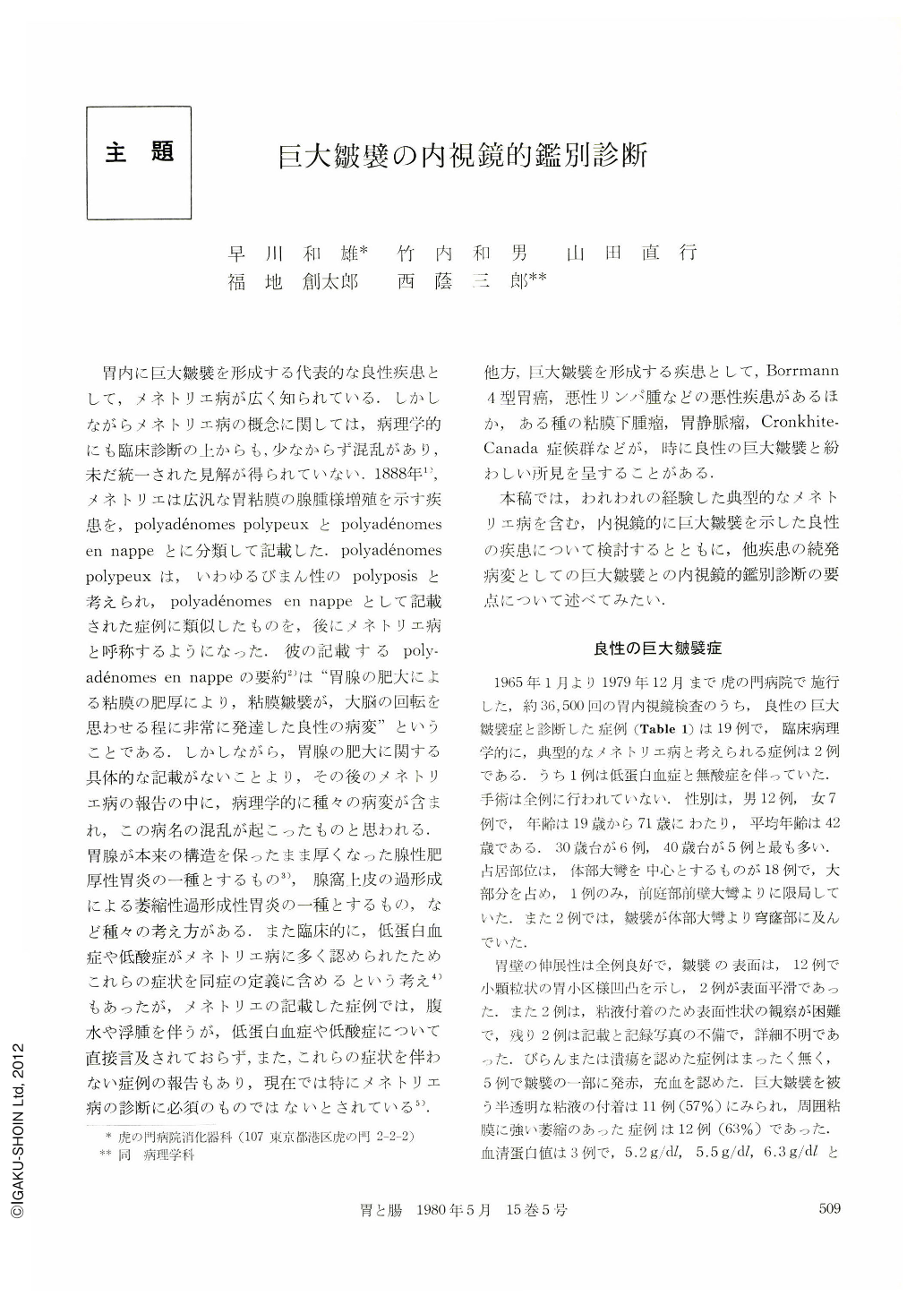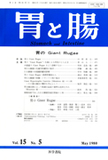Japanese
English
- 有料閲覧
- Abstract 文献概要
- 1ページ目 Look Inside
胃内に巨大皺襞を形成する代表的な良性疾患として,メネトリエ病が広く知られている.しかしながらメネトリエ病の概念に関しては,病理学的にも臨床診断の上からも,少なからず混乱があり,未だ統一された見解が得られていない.1888年1),メネトリエは広汎な胃粘膜の腺腫様増殖を示す疾患を,polyadénomes polypeuxとpolyadénomes ennappeとに分類して記載した.polyadénomes polypeuxは,いわゆるびまん性のpolyposisと考えられ,polyadénomesennapPeとして記載された症例に類似したものを,後にメネトリエ病と呼称するようになった.彼の記載するpolyadénomes ennappeの要約2)は“胃腺の肥大による粘膜の肥厚により,粘膜鍛襲が,大脳の回転を思わせる程に非常に発達した良性の病変”ということである.しかしながら,胃腺の肥大に関する具体的な記載がないことより,その後のメネトリエ病の報告の中に,病理学的に種々の病変が含まれ,この病名の混乱が起こったものと思われる.胃腺が本来の構造を保ったまま厚くなった腺性肥厚性胃炎の一種とするもの3),腺窩上皮の過形成による萎縮性過形成性胃炎の一種とするもの,など種々の考え方がある.また臨床的に,低蛋白血症や低酸症がメネトリエ病に多く認められたためこれらの症状を同症の定義に含めるという考え4)もあったが,メネトリエの記載した症例では,腹水や浮腫を伴うが,低蛋白血症や低酸症について直接言及されておらず,また,これらの症状を伴わない症例の報告もあり,現在では特にメネトリエ病の診断に必須のものではないとされている5).他方,巨大皺襞を形成する疾患として,Borrmann 4型胃癌,悪性リンパ腫などの悪性疾患があるほか,ある種の粘膜下腫瘤,胃静脈瘤,Cronkhite-Canada症候群などが,時に良性の巨大皺襞と紛わしい所見を呈することがある.
本稿では,われわれの経験した典型的なメネトリエ病を含む,内視鏡的に巨大皺襞を示した良性の疾患について検討するとともに,他疾患の続発病変としての巨大皺襞との内視鏡的鑑別診断の要点について述べてみたい.
As diseases which cause giant folds in the stomach, Menetriefs clisease and other benign types of giant folds as well as malignant ones such as B0rrrnann's type 4 gastric cancer and malignant lymphoma can be mentioned ancl also certain types of submucosal tumots, extragastric mass and gastric varices may be occasionally confused with some types of giant folds in endoscopic diagnostic differentiation. We made a survey cf cases having giant folds which were exarnined in this hospital in the last 15 years and classified them into benign cases of giant folds and others, and described what the critical points there were for endoscopic differentiation of the disease.
Of 19 cases classified as benign giant folds, 2 consiclered to be Menetrier's disease are introduced here for discussion. Some of the endoscopic characteristics of benign giant folds are, (1) The distensibility of the gastric wall is excellent. (2) They occur more centered in the part of the greater curvature of the corpus of the stomach. (3) On the surface, they usually show looks of regular convexo-concave pattern like the gastric area. (4) Often mucus secretion is enhanced. (5) No erosion or ulceration is seen. (6) Often, severe atrophy of mucosal membranes in the pyloric region is seen.
Of the 177 cases of Borrmann's type 4 gastric cancer, 114 cases (64%) had giant folds, most of which had some degree of erosion or ulceration combined, while only 17 cases did not have either erosion or ulceration (10%). Differentiation of such cases from benign giant folds is a problem, but by observing various endoscopic characteristics, it can be done without much confusion. Of the 20 cases of malignant lymphoma of the stomach,5 were found to have giant fold (5%), all combined with either polypoid lesion or ulceration. We have also described other several diseases of giant folds as critical points for differential diagnosis.

Copyright © 1980, Igaku-Shoin Ltd. All rights reserved.


